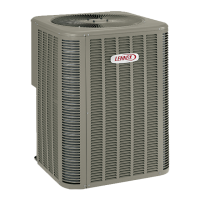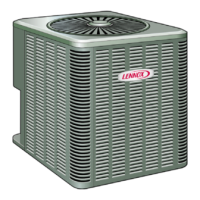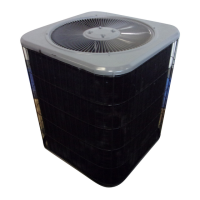Page 28
range of the sensor, the board will not perform demand or
time/temperature defrost operation and will display the
appropriate fault code. Heating and cooling operation will be
allowed in this fault condition.
Ambient and Coil Sensor
RESISTANCE (OHMS)
TEMPERATURE (ºF)
5750
7450
9275
11775
15425
19975
26200
34375
46275
62700
100
90
80
70
60
50
40
30
20
10
0
10000 30000 50000 70000 90000
85300
Figure 17. Temperature/Resistance Chart
Ambient Sensor—The ambient sensor (shown in figure
16) considers outdoor temperatures below -35°F (-37°C) or
above 120°F (48°C) as a fault. If the ambient sensor is
detected as being open, shorted or out of the temperature
range of the sensor, the board will not perform demand
defrost operation. The board will revert to time/temperature
defrost operation and will display the appropriate fault code.
Heating and cooling operation will be allowed in this fault
condition.
NOTE - Within a single room thermostat demand, if
5-strikes occur, the board will lockout the unit. Defrost board
24 volt power “R” must be cycled “OFF” or the “TEST” pins
on board must be shorted between 1 to 2 seconds to reset
the board.
Defrost Temperature Termination Shunt (Jumper)
Pins—The defrost board selections are: 50, 70, 90, and
100°F (10, 21, 32 and 38°C). The shunt termination pin is
factory set at 50°F (10°C). If the temperature shunt is not
installed, the default termination temperature is 90°F
(32°C).
DELAY MODE
The defrost board has a field-selectable function to reduce
occasional sounds that may occur while the unit is cycling in
and out of the defrost mode. When a jumper is installed on
the DELAY pins, the compressor will be cycled off for 30
seconds going in and out of the defrost mode. Units are
shipped with jumper installed on DELAY pins.
NOTE - The 30 second off cycle is NOT functional when
jumpering the TEST pins.
OPERATIONAL DESCRIPTION
The defrost control board has three basic operational
modes: normal, calibration, and defrost.
Normal Mode—The demand defrost board monitors the O
line, to determine the system operating mode (heat/cool),
outdoor ambient temperature, coil temperature (outdoor
coil) and compressor run time to determine when a defrost
cycle is required.
Calibration Mode—The board is considered uncalibrated
when power is applied to the board, after cool mode
operation, or if the coil temperature exceeds the termination
temperature when it is in heat mode.
Calibration of the board occurs after a defrost cycle to
ensure that there is no ice on the coil. During calibration, the
temperature of both the coil and the ambient sensor are
measured to establish the temperature differential which is
required to allow a defrost cycle.
Defrost Mode—The following paragraphs provide a
detailed description of the defrost system operation.
DETAILED DEFROST SYSTEM OPERATION
Defrost Cycles—The demand defrost control board
initiates a defrost cycle based on either frost detection or
time.
Frost Detection—If the compressor runs longer than
30 minutes and the actual difference between the clear
coil and frosted coil temperatures exceeds the
maximum difference allowed by the control, a defrost
cycle will be initiated.
IMPORTANT - The demand defrost control board will
allow a greater accumulation of frost and will initiate
fewer defrost cycles than a time/temperature defrost
system.
Time—If 6 hours of heating mode compressor run time
has elapsed since the last defrost cycle while the coil
temperature remains below 35°F (2°C), the demand
defrost control will initiate a defrost cycle.
Actuation—When the reversing valve is de-energized, the
Y1 circuit is energized, and the coil temperature is below
35°F (2°C), the board logs the compressor run time. If the
board is not calibrated, a defrost cycle will be initiated after
30 minutes of heating mode compressor run time. The
control will attempt to self-calibrate after this (and all other)
defrost cycle(s).
Calibration success depends on stable system
temperatures during the 20-minute calibration period. If the
board fails to calibrate, another defrost cycle will be initiated
after 45 minutes of heating mode compressor run time.
Once the defrost board is calibrated, it initiates a demand
defrost cycle when the difference between the clear coil and
frosted coil temperatures exceeds the maximum difference
allowed by the control OR after 6 hours of heating mode
compressor run time has been logged since the last defrost
cycle.
NOTE - If ambient or coil fault is detected, the board will not
execute the “TEST” mode.
Termination — The defrost cycle ends when the coil
temperature exceeds the termination temperature or after
14 minutes of defrost operation. If the defrost is terminated
by the 14-minute timer, another defrost cycle will be initiated
after 30 minutes of run time.
Test Mode — A TEST option is provided for
troubleshooting. See figure 18 for this function.

